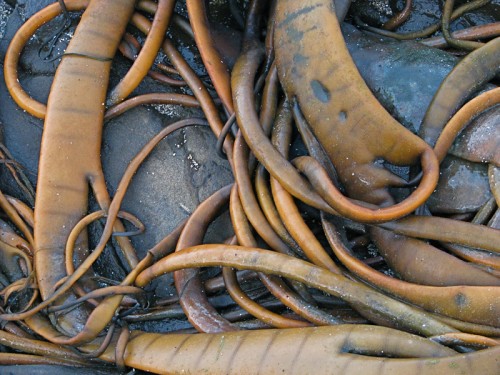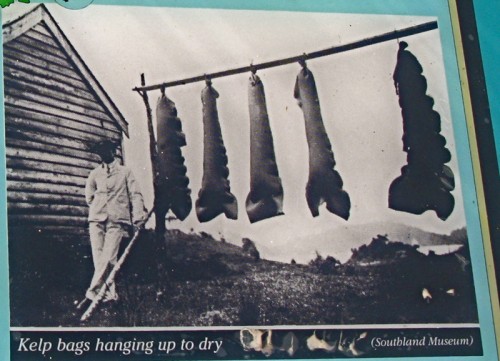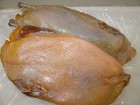Bull kelp and mutton birds
 The Bull kelp in NZ coastal waters is really robust stuff, and seems to be quite common along the rocky shores of the islands. The photo on the right is of some moderate sized kelp-wrack.
The Bull kelp in NZ coastal waters is really robust stuff, and seems to be quite common along the rocky shores of the islands. The photo on the right is of some moderate sized kelp-wrack.
After posting earlier about how Māori use kelp bags for storing Titi, I found I had a picture of poha-titi (Māori kelp containers) after all: it’s from a NZ Dept of Conservation (DOC) explanatory trail sign (which explains the odd quality of the photo) on the Ackers Point track on Stewart Island. The track leads through fairly intact bush ringing with Tui and Bellbirds to a headland overlooking the Foveaux Strait, the water which separates Stewart Island and the South Island. In season Ackers Point is heavily used for nesting by both Titi (Sooty shearwater) and Hoiho (Yellow-eyed penguin). Because we were there so late in the year there was no evidence of any nesting by either species. But the young Titi might actually still have been huddled hidden in their burrows in the flax and beech trees next to the trail under our feet, waiting for their adult plumage to finish coming in any day so they could take to the chilly sea.
So, this is what drying rimu (kelp) bags look like, on their way to being stuffed full of plump mutton birds. According to what I’ve read, the kelp is selected carefully, then the wider leaves are split, inflated and dried, then re-softened by working, like split suede. It’s at that point that cleaned and boiled mutton birds are packed into the kelp “bags” with the birds’ own rendered and strained fat, then the whole thing is laced together with harakeke (flax). In the old days it wasn’t uncommon for a bag to contain 20 or 40 birds! (Check out this brief page on Māori kai — food — basics).
Now, you can simply order muttonbird online, and it comes to you looking like this, with all the hard work already done:
(By the way, I’m definitely not endorsing ordering muttonbird online, and not just for conservation reasons. In the US, sea birds are protected, and it may well be highly illegal to import it here, like buying marine mammal products in Canada — you can buy them there, but you can’t legally bring them into the US.)
Photos: kelp, E. Shock; poha-titi, A. Shock
